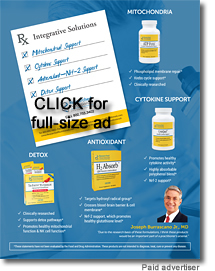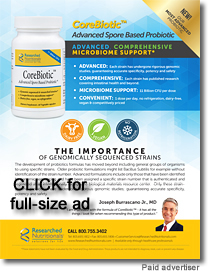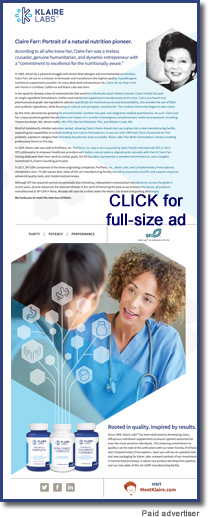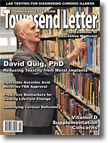|
Too many people sacrifice their health to gain wealth. Then they sacrifice their wealth to regain their health, too often living in the past and the future rather than in the moment that when they pass they barely have lived.
Predictive biomarkers can speed the transition from the current sick care system, which is unsustainable, to a more promising healthcare. A heavy lift, agreed, yet an attainable objective.
Predictive Biomarkers – Selection and Significance
Predictive biomarkers (PB) are defined here as the specific subset of tests that, when referenced to best outcome goal values rather than usual or normal statistical ranges, predict ten-year survival. Standards are rigorous for inclusion as a PB. To qualify, each test must predict all-cause mortality. This means the test has been performed and observed in every region, socioeconomic group, and with sufficient tracking of tests results over time to confirm ten-year predictive value. Each PB covers an aspect of epigenetics, lifestyle choices, and habits of daily living.
 Townsend Letter provides a platform for those examining and reporting on functional and integrative medicine. Please support these independent voices. Townsend Letter provides a platform for those examining and reporting on functional and integrative medicine. Please support these independent voices. |
For the first time, interpretation of these functional PB tests can include a lifestyle action plan based on quantitative risk reduction. Functional goals listed here cover all of epigenetics. Epigenetics includes the 92% of lifetime health determined by habits of daily living. This aspect of personalized medicine is proving effective in cost and outcome in studies to date. When compared to current best standards of care, a million lives lost prematurely and at high medical expense can be prevented at lower costs. The net result is to enrich society and reduce resource drain. This loss of life is predicted by modifiable epigenetic habits of daily living that can add life to years and years to life at high value to clients and communities and low human and financial costs.
 This proactive approach is evidence based and has been shown to lower costs while enhancing individual outcomes, reducing risks, and adding 'years to life and life to years.' This also helps to fulfill the triple aim of better health, better care, and lower costs. This proactive approach is evidence based and has been shown to lower costs while enhancing individual outcomes, reducing risks, and adding 'years to life and life to years.' This also helps to fulfill the triple aim of better health, better care, and lower costs.
This systems biology application of PB is the first conceptual advancement in lab medicine since sensitivity, specificity, and predictive index were introduced a generation ago. Integrative, comprehensive, personalized medicine now has evidence-based, objective, predictive biomarkers to determine and quantify both risk and response to therapy.
Usual (Statistical; 'Normal') Test Results vs. Predictive (Best Outcome; Anticipatory) Goal Value Results
Conventional clinical lab tests provide information about "usual" or "normal" statistical ranges for a particular item analyzed. They are useful for population studies yet not individually predictive.
PB tests provide information that delivers 'feel the difference results' within a few months of implementing individual habit changes based on the PB tests results.
The goal values recommended here for each predictive biomarker are designed to achieve the least risk or highest gain for each physiologic function measured. When predictive biomarker tests are at their goal value, all cause morbidity and mortality are at their best outcome value; quality of life and lifespan are optimized; net costs of care are reduced. PB goal values are not age adjusted because the interpretations of the tests results reported here are based on "least risk, best outcome" healthier goal values. Healthy people at all ages have the same lab ranges. As people accumulate age, there are more unhealthy people in each progressive decade. What we call aging is not only dependent on our genetic destiny but also on habits of daily living. While chronology is fixed, functional age is a choice. This is a reason why using predictive biomarkers based on goal values is an advancement compared to the previous statistical normality approach. The predictive goal values for the PB explained here are also based on evidence from many studies covering all ethnic groups over long periods of time in regard to all cause morbidity and mortality, that is, life expectancy. The probability of living ten plus years for these predictive biomarkers is also based on large scale, long-term community-based outcome studies.
Table 1 gives an overview of the predictive biomarkers here suggested with their clinical significance. (.pdf)
Predictive Biomarkers-The Smart Choice for Long-Term Health
Predictive biomarkers referenced to goal values and interpreted with a focus on epigenetic opportunities and lifestyle habit changes can stimulate virtuous behavior cycles, and be more cost effective and outcome effective when systematically applied. While each of thepredictive biomarkers is anticipatory, when four or more are interpreted together, their predictive power increases, covering the 92% of lifetime health determined by choice and habit when all eight are included.
 Although each PB test is a separate marker of a specific aspect of physiology, human systems are interdependent. When one biomarker is no longer at best outcome goal value, the entire organism is distressed, less resilient, and more at risk. Taken together this set of PB can identify both where healthy resilience exists and where risks should be reduced. Although each PB test is a separate marker of a specific aspect of physiology, human systems are interdependent. When one biomarker is no longer at best outcome goal value, the entire organism is distressed, less resilient, and more at risk. Taken together this set of PB can identify both where healthy resilience exists and where risks should be reduced.
While too many people live in denial about their health until some catastrophe occurs, professionals and consumers today are using predictive biomarkers to help assure and guide their lifestyle. These proactive consumers of health caring are likely to live well and prosper. It is possible to have a high quality of life throughout one's lifespan by living in harmony with individual nature and the season of that life. The 21st century poses a more challenging set of health risks than centuries before. The approach we outline herein acknowledges the challenges and addresses them in ways that are scientifically proactive, individual, and that utilize resources. This is a cradle-to-cradle approach employed in a system serving people in ways that are more efficient and personal.
When a biomarker shows higher risk, sooner rather than later is the time to take action and bring that marker back to or toward the best outcome value based on habits of daily living - what people eat, drink, think and do.
Physicians and consumers can choose to acknowledge the challenges of contemporary living and incorporate advances in informatics, human behavior, and enhanced caring. Incentives do change behavior. Emotional, psychological, and financial incentives affect choices people make. It is time for healthcare to embrace the opportunities of systems biology, evidence-based predictive testing, and individual care whose outcomes can be verified within months while predicting favorable results decades ahead.
References available on request.
This approach builds upon the concept of "optimum" or "high-level health" reference ranges pioneered by Emanuel Cheraskin and colleagues, (Cheraskin E, Ringsdorf WM. Predictive Medicine. 1977) and makes the elegant biochemical individuality concept useful in individual practice. (Williams RJ, et al. The Wonderful World Within You. John Wiley, 1998, 3rd edition)
Resources
For information on obtaining functional predictive biomarker testing: ELISA/ACT Biotechnologies: 1.800.553.5472, www.ELISAACT.com
Healthcare practitioners can watch a recorded virtual workshop on Predictive Biomarkers. https://www.elisaact.com/workshop/
Clinical protocols for these eight predictive biomarkers can be obtained by contacting:
 Dr. Russell Jaffe received his AB, MD (with Senior Thesis Honors), and PhD (in biochemistry and physiology) from Boston University, all in May 1972. Dr. Jaffe served his medical internship at University Hospital and was awarded a United States Public Health Service Officer Commission, assigned to the Clinical Center of the National Institutes of Health in June 1973. He is board certified in clinical and subspecialty certified in chemical pathology. Dr. Jaffe remained on the permanent senior staff of the NIH Clinical Pathology Department where he continued method innovation and was active in collaborative research with the Laboratory of Experimental Atherosclerosis (of the Heart, Lung, and Blood Institute). Concurrently, Dr. Jaffe's interests in the mechanisms of health and the evoking of human healing responses led him to apprentice in such healing arts as acupuncture, mindfulness, massage, music, art and color therapy, and a variety of eclectic therapeutic approaches. Dr. Russell Jaffe received his AB, MD (with Senior Thesis Honors), and PhD (in biochemistry and physiology) from Boston University, all in May 1972. Dr. Jaffe served his medical internship at University Hospital and was awarded a United States Public Health Service Officer Commission, assigned to the Clinical Center of the National Institutes of Health in June 1973. He is board certified in clinical and subspecialty certified in chemical pathology. Dr. Jaffe remained on the permanent senior staff of the NIH Clinical Pathology Department where he continued method innovation and was active in collaborative research with the Laboratory of Experimental Atherosclerosis (of the Heart, Lung, and Blood Institute). Concurrently, Dr. Jaffe's interests in the mechanisms of health and the evoking of human healing responses led him to apprentice in such healing arts as acupuncture, mindfulness, massage, music, art and color therapy, and a variety of eclectic therapeutic approaches.
Dr. Jaffe developed the first method of measuring cell-mediated immunity using a modified ELISA system in a lymphocyte mitogenesis/blastogenesis brief cell culture known as lymphocyte response assays (LRA).
Dr. Jaffe is a Fellow of the Health Studies Collegium and Director of ELISA/ACT Biotechnologies, LLC and PERQUE, LLC. Dr. Jaffe may be reached at 800-525-7372 x 5101 and by email at rjaffe@4HSC.org, rjaffe@ELISAACT.com or rjaffe@PERQUE.com.
Jayashree Mani is a certified clinical nutritionist (CCN). She is experienced in the effective implementation of the comprehensive program described in this article involving these predictive biomarkers, LRA by ELISA/ACT tests, Health Appraisal Questionnaires (HAQ), Alkaline Way diet, and PERQUE nutraceuticals.
|
![]()
![]()
![]()
![]()









